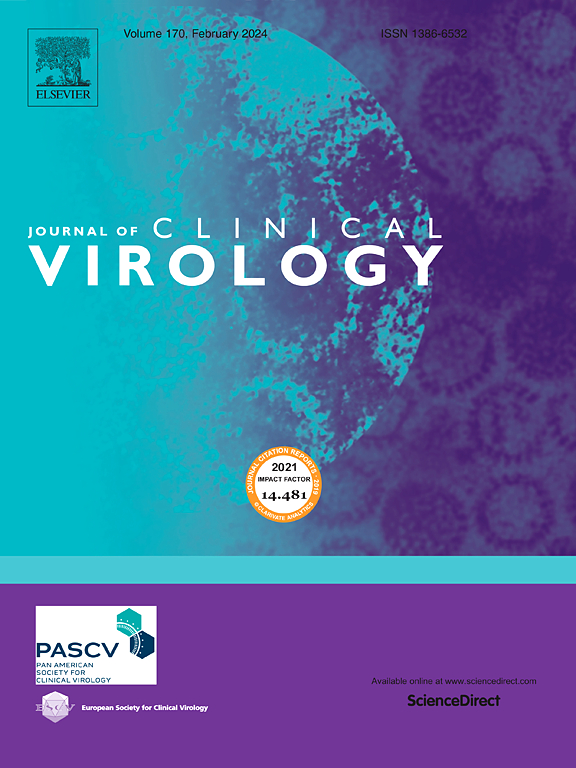经胎盘CMV和VZV IgG转移的胎龄依赖性动力学:早产儿和足月新生儿(24-41周)的每周比较分析
IF 3.4
3区 医学
Q2 VIROLOGY
引用次数: 0
摘要
母体IgG抗体经胎盘移植可促进胎儿对巨细胞病毒(CMV)和水痘-带状疱疹病毒(VZV)感染的免疫。关于全胎龄抗体转移的综合数据,特别是在28周之前,仍然有限。方法本前瞻性队列研究分析了n = 564对(孕24-41周)母婴的成对血液样本。采用elisa检测抗巨细胞病毒和抗vzv IgG浓度,采用内部细胞培养法评估巨细胞病毒中和能力。结果新生儿CMV和VZV抗体浓度在24-29周显著低于母体水平(p <;0.05)。CMV在30-34周达到平衡,VZV在30-33周达到平衡。超过35周的巨细胞病毒和34周的VZV,新生儿浓度显著超过母体水平(p <;0.05)。新生儿CMV中和能力在24-29周显著低于30-34周(p <;0.05),第35 ~ 41周(p <;0.01),妊娠期间逐渐改善。母亲的中和能力在整个妊娠期保持不变。新生儿和母亲在中和能力方面的差异是渐进的:在第24-29周最小,在第30-34周显著增加(p <;0.05),而35-41周新生儿的最高水平(p <;0.01),表明定性抗体转移增强。性别和双胎妊娠对抗体转移均无显著影响。结论胎龄依赖性的CMV和VZV IgG抗体转移早在第24周发生。极早产儿表现出明显较低的抗体浓度和CMV中和能力。有针对性的预防策略,为这一弱势群体和进一步的研究,调查具有高中和能力的抗体优先母婴转移是必要的。本文章由计算机程序翻译,如有差异,请以英文原文为准。
Gestational age-dependent dynamics of transplacental CMV and VZV IgG transfer: Weekly comparative analysis in preterm and full-term neonates (24–41 weeks)
Background
Transplacental transfer of maternal IgG antibodies promotes foetal immunity against cytomegalovirus (CMV) and varicella-zoster virus (VZV) infections. Comprehensive data on antibody transfer across gestational ages, particularly before 28 weeks, remain limited.
Methods
This prospective cohort study analysed paired maternal and newborn blood samples from n = 564 mother–child pairs (gestational weeks 24–41). Anti-CMV and anti-VZV IgG concentrations were measured using ELISA-tests and CMV neutralising capacity was assessed using an in-house cell culture-based assay.
Results
Newborn antibody concentrations were significantly lower than maternal levels at 24–29 weeks for both CMV and VZV (p < 0.05). Equilibrium was reached at weeks 30–34 for CMV and 30–33 for VZV. Beyond week 35 for CMV and week 34 for VZV, newborn concentrations significantly surpassed maternal levels (p < 0.05). CMV neutralisation capacity in neonates was significantly lower during weeks 24–29 compared to weeks 30–34 (p < 0.05) and weeks 35–41 (p < 0.01), showing progressive improvement during gestation. Maternal neutralising capacity remained constant across all gestational intervals. The newborn-maternal difference in neutralising capacity was progressive: minimal at weeks 24–29, significantly greater at weeks 30–34 (p < 0.05), and maximum levels in neonates at weeks 35–41 (p < 0.01), indicating enhanced qualitative antibody transfer. Neither gender nor twin-pregnancies showed a significant effect on antibody transfer.
Conclusions
Gestational age-dependent transplacental CMV and VZV IgG antibody transfer occurs as early as week 24. Extremely preterm infants showed significantly lower antibody concentrations and CMV neutralising capacity. Targeted prevention strategies for this vulnerable population and further studies investigating the preferential materno-foetal transfer of antibodies with high neutralisation capacities are warranted.
求助全文
通过发布文献求助,成功后即可免费获取论文全文。
去求助
来源期刊

Journal of Clinical Virology
医学-病毒学
CiteScore
22.70
自引率
1.10%
发文量
149
审稿时长
24 days
期刊介绍:
The Journal of Clinical Virology, an esteemed international publication, serves as the official journal for both the Pan American Society for Clinical Virology and The European Society for Clinical Virology. Dedicated to advancing the understanding of human virology in clinical settings, the Journal of Clinical Virology focuses on disseminating research papers and reviews pertaining to the clinical aspects of virology. Its scope encompasses articles discussing diagnostic methodologies and virus-induced clinical conditions, with an emphasis on practicality and relevance to clinical practice.
The journal publishes on topics that include:
• new diagnostic technologies
• nucleic acid amplification and serologic testing
• targeted and metagenomic next-generation sequencing
• emerging pandemic viral threats
• respiratory viruses
• transplant viruses
• chronic viral infections
• cancer-associated viruses
• gastrointestinal viruses
• central nervous system viruses
• one health (excludes animal health)
 求助内容:
求助内容: 应助结果提醒方式:
应助结果提醒方式:


